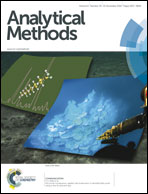The analysis of faecal sterols in sediment samples by HPLC-UV using ultrasound-assisted treatment
Abstract
A method was developed for the analysis of faecal sterols in sediment samples by ultrasound-assisted extraction and quantification by HPLC with a UV detector. A reversed-phase C18 column was used to develop the method and optimal conditions were employed for elution under isocratic conditions using a methanol/THF/water (83 : 9 : 8) as the mobile phase. Direct detection of sterols by HPLC is difficult, so a derivatization procedure using benzoyl chloride was performed. A sample treatment using ultrasound-assisted extraction with 40 mL of methylene chloride–methanol (1 : 1) for 30 min without a clean up step was developed. The recoveries obtained ranged from 65 to 89% for the sample spike and from 67 to 101% for the blank spike. The detection limits ranged from 1.90 mg L−1 for β-sitosterol to 4.17 mg L−1 for epicoprostanol. Seven streams of Juiz de Fora city were analysed and the concentrations of coprostanol in the sediment samples varied between 0.01 and 14.48 μg g−1. Except for the farm forest sample stream, all others were considered contaminated by faeces using the parameters and evaluation criteria for this type of contamination.


 Please wait while we load your content...
Please wait while we load your content...